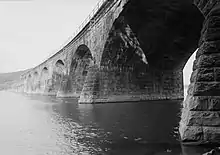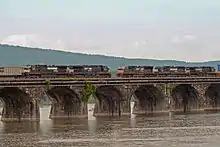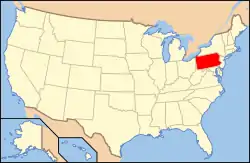Rockville Bridge
The Rockville Bridge, at the time of its completion in 1902, was, and remains, the longest stone masonry arch railroad viaduct in the world.[2] Constructed between April 1900 and March 1902 by the Pennsylvania Railroad, it has forty-eight 70-foot spans, for a total length of 3,820 feet (1,160 m).[2]
Rockville Bridge | |
|---|---|
 Rockville Bridge in 1999 | |
| Coordinates | 40.3334°N 76.9103°W |
| Carries | 2 rail lines for Norfolk Southern Railway and Amtrak Pennsylvanian |
| Crosses | Susquehanna River |
| Locale | Just south of Marysville, Pennsylvania |
| Maintained by | Norfolk Southern Railway |
| Characteristics | |
| Design | Stone masonry arch bridge |
| Total length | 3,820 feet (1,164 m) |
| Width | 52 feet (16 m) |
| Longest span | 70 feet (21 m) (48 equal spans) |
| Clearance below | 43 feet (13 m) to avg. level of rock bottom |
| History | |
| Opened | March 30, 1902 |
| Designated | April 29, 2010[1] |
| Location | |

| |


The bridge crosses the Susquehanna River about 5 miles (8 km) north of Harrisburg, Pennsylvania. The eastern end is in Rockville, and the western end is just south of Marysville.
History
The original bridge on the spot opened on September 1, 1849, when the PRR began operating over it. The Northern Central Railway began to use it after abandoning their Marysville Bridge. The current bridge was built by Italian laborers, who worked for two contractors (Drake & Stratton Co. and H.S. Kerbaugh), one on the east side of the Susquehanna River and one on the west.[3] Local people from the Harrisburg area also worked on the bridge.
For most of its life the bridge carried four main line tracks. They were reduced to three in the 1980s when the PRR Main Line was modernized across Pennsylvania. In the late 1990s an intermodal container was blown off an intermodal freight train and landed in the river, prompting Norfolk Southern to reconfigure the track layout by terminating the wye track to Enola at the west end of the bridge. This reduced the number of main line tracks to two, but left a buffer zone on either side to prevent further containers ending up in the river, although high winds from the departing December 2010 North American blizzard resulted in a similar outcome on December 27, 2010.[4]
The track from the west side of the bridge was shortened back to a new CP point named "Mary" not because of wind blowing containers off, but because the curve in the switch at the former location caused lateral forces to blow out the side of the spandrel. This led to the failure of the downriver side under the weight of a coal train. When the spandrel failed, it also disproved the once popular thought that the core of the bridge was filled with concrete. During times of high wind it is routine to park heavy trains on the bridge as a wind shield. Currently, the bridge is used by the Norfolk Southern Railway and Amtrak. The bridge was listed on the National Register of Historic Places in 1975 and was designated as a National Historic Civil Engineering Landmark in 1979.[5][6]
See also
References
- "PHMC Historical Markers Search" (Searchable database). Pennsylvania Historical and Museum Commission. Commonwealth of Pennsylvania. Retrieved 2014-01-25.
- "National Register of Historic Places Inventory -- Nomination Form" (PDF). Retrieved 2007-04-16.
- Harrisburg Area Riverboat Society (November 29, 2006). "Bridges on the Susquehanna River". harrisburgriverboat.com. Archived from the original on December 16, 2006. Retrieved 2006-11-29.
- WHTM-TV article on containers blown off bridge Retrieved 2010-12-27
- "Rockville Bridge". archiplanet.org/. 2006. Retrieved 2007-01-08.
- Treese, Lorett (2003). Railroads of Pennsylvania: Fragments of the Past in the Keystone Landscape. Mechanicsburg, PA: Stackpole Books. p. 77. ISBN 9780811726221.
Further reading
- Cupper, Dan (2002). Rockville Bridge -- Rails Across the Susquehenna. Withers Publishing, Pennsylvania (USA). ISBN 1-881411-34-6.
- Jackson, Donald C. (1984). Great American Bridges and Dams. John Wiley & Sons, New York (USA). ISBN 0-471-14385-5.
- Spavins, Jim (2009). 90 Days to Rockville. CreateSpace, California (USA). ISBN 978-1-4486-5534-2.
External links
| Wikimedia Commons has media related to Rockville Bridge. |
- Historic American Engineering Record (HAER) No. PA-524, "Pennsylvania Railroad, Rockville Bridge"
- Pennsylvania's Historical Architecture and Archaeology site photos:
- Rockville Bridge (photos and information)
- Rockville Arch Bridge at Structurae
- Rockville Bridge Photos (November 5, 2005)
- Stan's Railpix : Conrail Photo Gallery ( Rockville Bridge photos from Nov -1994 )

